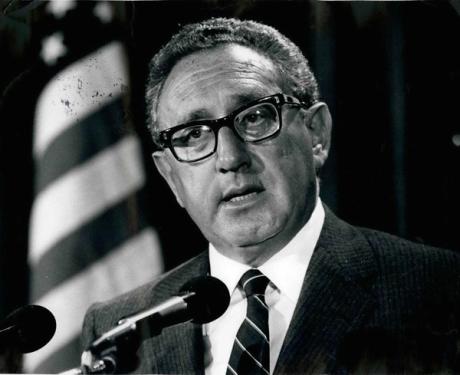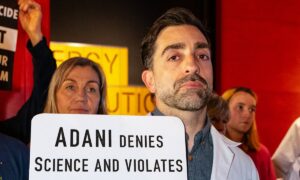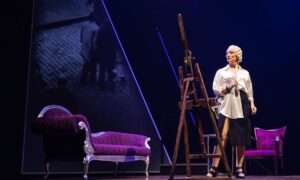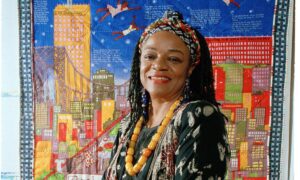
Henry Kissinger, one of the most consequential and controversial international political figures of his generation, and the subject of artistic protest and satire from artists including Philip Guston and Alfredo Jaar, has died, aged 100.As US secretary of state to President Richard Nixon and then his successor President Gerald Ford—and an adviser in some capacity to every US president since—Kissinger was an agent of American realpolitik and peace-making in the 1970s, and of the US rapprochement with Communist China that led to Nixon’s celebrated visit to China in 1972 to meet Mao Tse-Tung. As the architect of US diplomacy in southeast Asia, and of the country’s engagement in Vietnam, Cambodia and Laos, involving carpet-bombing, destructive regime change—as well as of US support of right-wing regimes in Argentina and Chile—Kissinger found himself the target of human rights protests for the past half-century, and a most controversial winner of a Nobel Peace Prize in 1973.In the 1970s—an era noted for standout eyewear sported by the likes of the artist Andy Warhol, the rockstar Elton John and the singer Nana Mouskouri—Kissinger’s broad-framed spectacles (then at their broadest and blackest) could hold their own as an instantly recognisable graphic device. In his 1971 “Richard Nixon“ drawings, Guston, disgusted at US engagement in southeast Asia, represented Nixon as either a Ku Klux Klan figure or a scrotum and penis—three years before he resigned in disgrace after the Watergate affair—while Kissinger was depicted as a disembodied pair of thick-rimmed spectacles.The biting Nixon and Kissinger drawings were inspired by Guston reading some early chapters of his friend Philip Roth’s Our Gang, his satirical tale of Trick E Dixon. They were the subject of an exhibition, Philip Guston: Laughter in the Dark, Drawings From 1971 & 1975, at Hauser & Wirth, West 22nd Street, New York, in 2016-17.In Searching for K (1986), the Chilean artist Alfredo Jaar appropriated pages from Kissinger’s 1979 and 1982 memoirs to track Kissinger’s role in the overthrow of democracy in Chile in 1973, and the rise to dictatorial power of General Augusto Pinochet.In the early 2000s, the artist Jan Frank produced a series of large canvases featuring Philip Guston-style renderings of the former secretary of state’s thick-frame glasses, collectively entitled The Nixon Suite. In 2009, The Art Newspaper reported that “when Frank heard that Mr Kissinger was in New York, in order to be photographed by his old friend Steve Pyke, the New Yorker staff portraitist, Frank wasted no time in transporting his gigantic diptych of Henry’s specs up to the sitting. Security was understandably very tight yet Frank managed to wheedle his outsize canvas up to the photography studio and thus, finally, the politician was photographed by Pyke right in front of the glasses painting, an intriguing image currently on view at Pyke’s show of new portraits at Flowers
-

on Madison Avenue.”A son of BavariaKissinger was born Heinz Kissinger in 1923 in Bavaria. Following the Nazi’s rise to power a decade later, he found himself the subject of anti-semitic bullying at school, and his family fled Germany in 1938, first to London and then to New York.Long before his political ascendency in Washington, Kissinger had made a brilliant reputation as a Harvard academic, where his Harvard International Seminar helped build his international connections. His study of the Congress of Vienna, A World Restored: Metternich, Castlereagh and the Problems of Peace, 1812-22 (1957) elaborated his “great-man” view of history, which fed through into his life as the most influential diplomat of his day, when he traded on one-to-one connections and secret negotiation. “As a child of the Holocaust and a scholar of Napoleonic-era statecraft,” Walter Isaacson wrote in his biography Kissinger (1992), “[Kissinger] sensed that great men as well as great forces were what shaped the world, and he knew that personality and policy could never be fully divorced. Secrecy came naturally to him as a tool of control. And he had an instinctive feel for power relationships and balances, both psychological and geostrategic.”When Richard Avedon took Kissinger’s photograph in 1976—a celebrated statesmanlike image now in the collection of the Metropolitan Museum of Art—Kissinger asked Avedon to “be kind”. “I would have liked to have asked him,” Avedon told the writer Alain Elkann in 2014, “what he meant by that. Should I have made Kissinger younger, taller, or thinner?”Kissinger was an illustrator’s staple for his cover appearance on the news magazines Time and Newsweek, including a famous “Superman” cover of the latter in June 1974, at the height of the Watergate scandal, when Kissinger was often Nixon’s only confidante as the president’s time in office drew to an end. The Vietnamese caricaturist Nguyen Hai Chi (Choé) depicted him as the Statue of Liberty, but carrying a bullwhip.Kissinger, a noted art collector and sometime trustee of the Metropolitan Museum of Art in New York, was a ubiquitous figure at international gatherings of the great and good, and was back in China earlier this year, honoured by Xi Jinping and his regime, half a century after the days of “Nixon in China”. The American satirist Gore Vidal, in his memoir Palimpsest (1995), describes encountering Kissinger in Rome on an evening when the Italian industrialist Gianni Agnelli and his family had taken over the newly restored Sistine Chapel, followed by a dinner in the Hall of the Statues in the Vatican. “As I left [Kissinger] gazing thoughtfully at at the hell section of [Michelangelo’s] The Last Judgement (as pretty and bright now as Tiepolo),” Vidal writes, “I said to the lady with me, ‘Look he’s apartment hunting’.”Heinz (Henry) Alfred Kissinger; born Fürth, Bavaria, 27 May 1923; US national security adviser 1969-75; US secretary of state 1973-77; Nobel Peace Prize 1973; married 1949 Ann Fleischer (one son, one daughter; marriage dissolved 1964), 1974 Nancy Maginnes; died Kent, Connecticut, 29 November 2023.




























